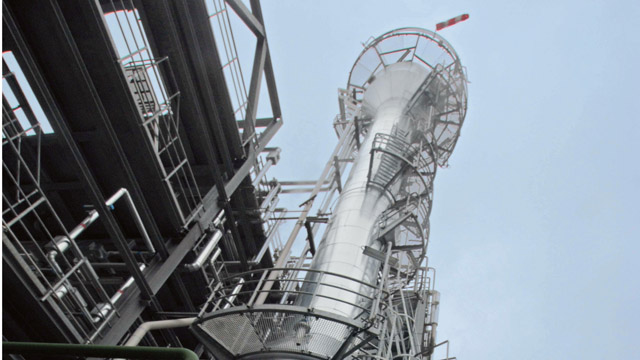Deasphaltierung mit Lösungsmitteln
Die Entfernung von Asphaltenen aus Rückständen ist bei der Produktion von Schmieröl entscheidend. Bei der Lösemittelrückgewinnung und beim Stripping der Asphaltene/Harzgemische sowie des deasphaltierten Öls verbessern Wärmeübertrager von Alfa Laval die Energieeffizienz bei maximierter Lösemittelrückgewinnung. Unsere Spiralwärmeübertrager mit geringer Foulingneigung eignen sich bestens für Medien mit hohem Foulinggrad.
Optimizing refinery solvent de-asphalting processes
Increasingly, refineries are using solvent deasphalting processes to upgrade heavy residues into valuable products. Alfa Laval has the expertise, equipment and services to help refineries increase margins by cost-effectively converting the bottom-of-the-barrel residues thereby raising both yield and margins.
Improving energy efficiency
The oil/solvent mixture from the extractor must be preheated prior to entering the separator where solvent is recovered from the de-asphalted oil. Typically this is accomplished by reusing energy from the recovered solvent in traditional shell-and-tube heat exchangers. This often results in a huge heat recovery service that requires up to 20 traditional shell-and-tube heat exchangers due to the supercritical oil/solvent mixture and the very tight temperature approach required in order to maximize energy recovery.
High-efficiency Alfa Laval heat exchangers maximize energy recovery while minimizing the number and size of the heat exchangers required for this service. This significantly reduces the energy input required for final preheating as well as the cooling capacity for final solvent cooling.
Mitigating fouling in refinery solvent recovery
Due to the high content of asphaltene that precipitates on the heat transfer walls, final cooling of asphaltene/resin pitch can be a high-fouling service. Fouling in traditional shell-and-tube heat exchangers can sometimes be so severe that it limits the capacity of the entire process and causes cleaning costs to sky-rocket.
Low-fouling Alfa Laval spiral heat exchangers minimize fouling tendencies through controlled channel velocities and low hold-up times. This means that there are no limitations to the process throughput. Moreover, when cleaning is required, downtime and cost is minimized thanks to easy access to the heat transfer channels.
Maximizing solvent recovery
The more vapour that is condensed, the more solvent is recovered. Vapour condensing is generally accomplished by means of ordinary cooling water, which means that the amount of vapour that can be condensed is limited by the temperature of the cooling water.
Traditional shell-and-tube heat exchangers require a certain temperature difference to limit the number and size of the exchangers required.
A high-efficiency Alfa Laval heat exchanger provides a temperature approach as low as 3°C. This means that a single Alfa Laval unit is a sound, economical alternative to traditional shell-and-tube heat exchangers. Moreover, our heat exchangers maximize vapour condensing capacity, thereby recovering the maximum amount of solvent.
Reducing CAPEX
Using traditional shell-and-tube heat exchangers can be expensive, especially when energy recovery requires several large, bulky units in series, or when installation on construction is needed to condense vapours. High-efficiency Alfa Laval heat exchangers significantly reduce equipment and installation costs while maximizing efficiency using minimal plot space and flooded weight.
Proven technology for refinery solvent de-asphalting
Alfa Laval heat exchangers operate as interchangers, vapour condensers and pitch coolers in solvent de-asphalting plants around the world, delivering savings in capital expenditures as well as energy and maintenance costs.

